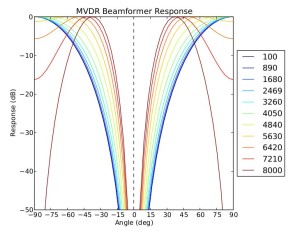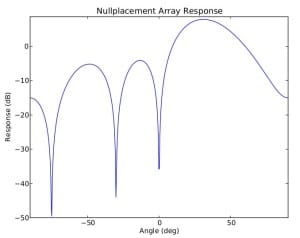Beamsteering is the changing of the main lobe of a broadband beamformer’s response. This allows directional reception and spatial selectivity. With a beamformer that can steer, the user can actively select which sources to listen to while effectively blocking other signals coming from outside the direction of interest. Here we demonstate the use of beamsteering in the MVDR Broadband Beamformer.
The MVDR Solution
The MVDR solution is given by:
![]() Where Rxx is the autocorrelation matrix of the incoming signal, C is the constraint matrix, and f is the desired response vector. The recursive version is given by:
Where Rxx is the autocorrelation matrix of the incoming signal, C is the constraint matrix, and f is the desired response vector. The recursive version is given by:
MVDR Beamsteering
Suppose we have sources coming from an angle of about +- 45 degrees from broadside. Using the MVDR Beamformer, we can design a set of weights wopt such that we can electronically capture
this signal with maximum gain. Such a set of weights has the following beampattern:
As the figure shows, the MVDR beampattern is maximized in the look directions, while minimized
in others. As with the broadside responses, the new main lobes are wider at low frequencies while
becoming narrower at high frequencies.
Null Placement
With this technology, we can also place nulls at certain angles in order to block signals. Suppose there are interfering signals coming from -75, 30, and 0 degrees. We can design a set of weights to block these signals. For a given frequency, such weights have the following beampattern:
As the figure illustrates, the beampattern is exhibits nulls at these desired frequencies while attempting to maximize the gain outside these frequencies.
Product Offerings
VOCAL Technologies offers custom designed data adaptive beamforming solutions, with MVDR filters as a potential front end. Our custom implementations of such systems are meant to deliver optimum performance for your specific signal processing task. Contact us today to discuss your solution!

